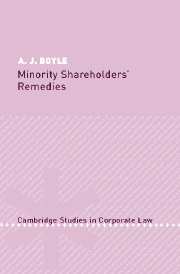2 - Shareholder actions by exception to the rule
Published online by Cambridge University Press: 11 July 2009
Summary
Direct and derivative actions
The type of shareholders' remedy first explored in this chapter is the derivative action. This will be examined both in respect of the substantive law grounds on which such an action may be based and, later, of its procedural character. The scope of the common law derivative action is defined by the nature of the remedy which is sought. A derivative action is concerned with recovering damages, property or funds which belong to the company for wrongs done to it. In most cases, this involves a serious breach of directors' duties, but the derivative form of action is only appropriate where recovery for the company will result from a successful judgment. Where the remedy sought is an injunction or declaration to prevent an abuse of power by directors, the action is not properly classified as derivative. This distinction has been amply clarified in the case of actions based on ultra vires activities. Where the plaintiff shareholder seeks only to restrain a proposed ultra vires transaction, the action will not take the derivative form. In contrast, where the plaintiff seeks to ‘unscramble’ an existing ultra vires transaction, the recovery of property (and possibly damage for breach of duty by directors) necessitates that the proceeding takes the derivative form.
Extensive attention is given in this chapter to the problems posed by the derivative action. The Court of Appeal's decision in Prudential Assurance Co. Ltd v. Newman Industries Ltd (No. 2) was widely viewed as heralding the ‘death knell’ of the derivative action so far as public companies were concerned.
- Type
- Chapter
- Information
- Minority Shareholders' Remedies , pp. 24 - 59Publisher: Cambridge University PressPrint publication year: 2002

